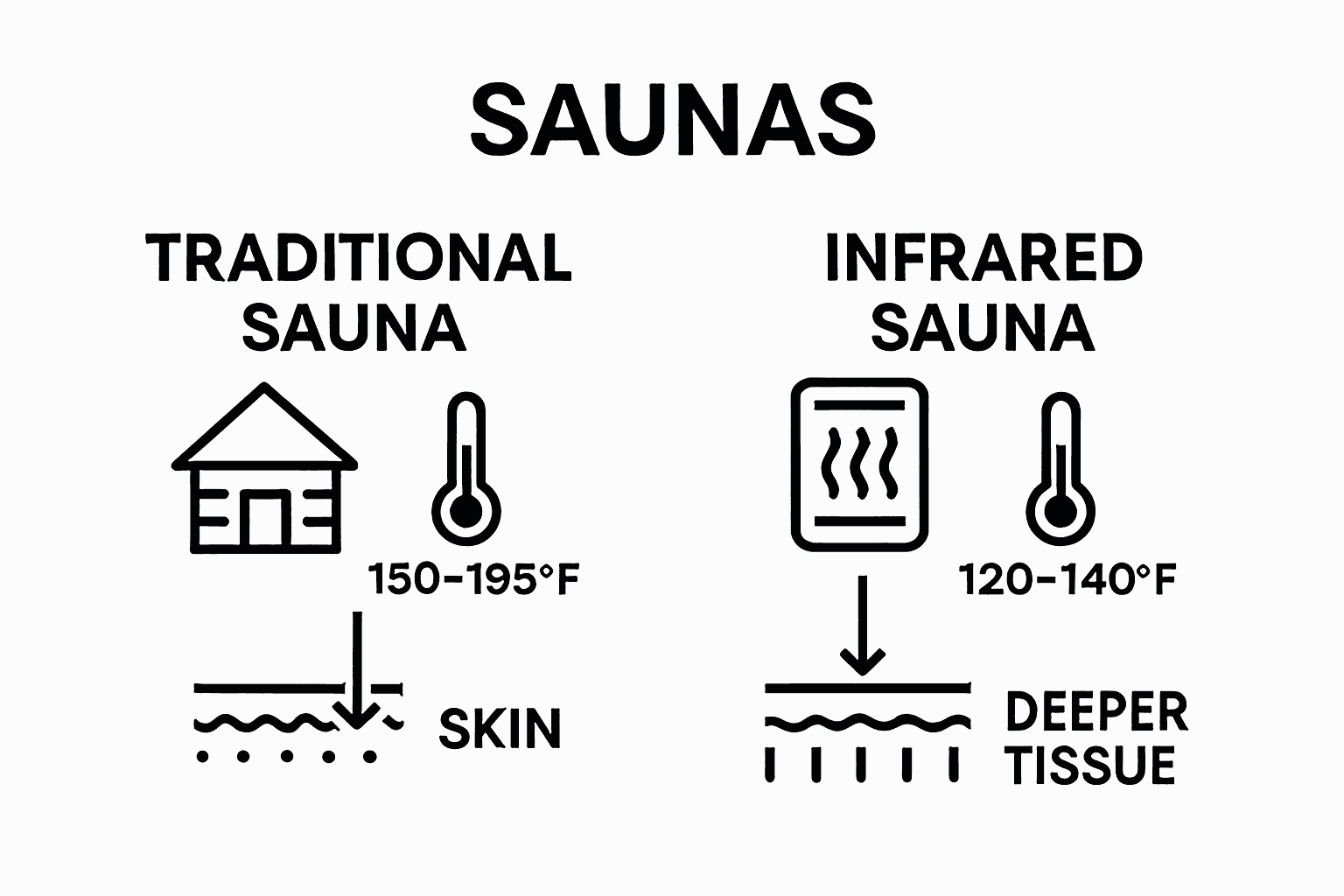
Understanding Sauna Benefits Overview for Wellness Seekers
Stepping into a sauna does more than just make you sweat. The intense temperatures go way beyond simple relaxation and reach as high as 195 degrees Fahrenheit. Most people think it stops at a soothing warm-up but studies show regular sauna sessions can affect your heart, brain, and even your immune system in ways that surprise the experts.
Table of Contents
- What Is A Sauna And How Does It Work?
- Why Sauna Use Matters For Health And Wellness
- Physiological Benefits Of Regular Sauna Sessions
- The Role Of Saunas In Relaxation And Stress Relief
- Sauna Types And Their Unique Benefits
Quick Summary
| Takeaway | Explanation |
|---|---|
| Saunas enhance cardiovascular health. | Regular sauna sessions mimic moderate exercise, improving circulation and heart function without physical movement. |
| Saunas reduce stress and anxiety. | The heat environment lowers cortisol levels and increases endorphins, promoting mental relaxation and emotional balance. |
| Heat exposure supports cellular recovery. | Saunas activate heat shock proteins, enhancing cellular repair and boosting immune function during sessions. |
| Different saunas offer varied benefits. | Options like traditional and infrared saunas provide unique heat experiences tailored to individual health needs and comfort levels. |
| Regular sauna use promotes overall wellness. | Consistent sessions contribute to physical and mental health, addressing relaxation, detoxification, and emotional stability. |
What is a Sauna and How Does it Work?
A sauna represents a specialized heated environment designed to promote wellness through controlled heat exposure. Scientific research reveals these unique spaces can significantly impact human physiological responses, offering more than just a relaxation experience.
The Basic Sauna Structure
Saunas typically consist of a small enclosed room constructed from heat-resistant wood like cedar or spruce, engineered to maintain high temperatures between 150 to 195 degrees Fahrenheit. The interior space allows individuals to sit or recline while experiencing intense dry or wet heat. Traditional saunas generate heat through electric heaters or wood-burning stoves, creating an environment that triggers profound bodily responses.
Physiological Mechanisms of Heat Exposure
When you enter a sauna, your body undergoes remarkable adaptive processes.
The extreme heat causes immediate cardiovascular changes, including increased heart rate and dilated blood vessels. Your skin temperature can rise several degrees, which prompts significant sweating as a natural cooling mechanism. These physiological reactions mimic moderate cardiovascular exercise, stimulating multiple health benefits.
Key bodily responses during sauna sessions include:
- Accelerated heart rate similar to light physical activity
- Increased peripheral blood circulation
- Enhanced metabolic processes
- Activation of heat shock proteins that support cellular repair
Understanding these intricate biological mechanisms helps explain why saunas have been valued across cultures for centuries as tools for relaxation, detoxification, and overall wellness maintenance. The controlled heat environment triggers complex yet natural bodily adaptations that contribute to improved physical and mental health.
This table summarizes the major physiological effects and wellness benefits associated with regular sauna sessions, serving as a quick reference for wellness seekers.
| Benefit Category | Description | Related Physiological Response |
|---|---|---|
| Cardiovascular Health | Improved blood circulation, reduced cardiac strain, regulated blood pressure | Heart rate increase, vessel dilation |
| Stress Reduction | Lowered cortisol levels, improved mood, decreased anxiety | Neurochemical endorphin release |
| Metabolic Enhancement | Boosted metabolic processes, increased caloric burn | Enhanced metabolic efficiency |
| Cellular Recovery | Stimulated cellular repair and immune cell circulation | Activation of heat shock proteins |
| Muscle Relaxation | Relief from muscle tension, faster physical recovery | Increased blood flow, relaxed muscle fibers |
| Improved Sleep | Enhanced sleep quality due to reduced stress and relaxed body | Calming effect, hormonal balance |
Why Sauna Use Matters for Health and Wellness
Medical research highlights that sauna use extends far beyond simple relaxation, representing a powerful wellness intervention with comprehensive health benefits. These intentional heat exposure sessions offer a holistic approach to physical and mental restoration, transforming how we approach personal health maintenance.
Cardiovascular and Metabolic Benefits
Regular sauna sessions trigger profound physiological responses that support cardiovascular health. When exposed to intense heat, blood vessels dilate, promoting improved circulation and reducing potential cardiovascular strain. The cardiovascular workout mimics moderate exercise, stimulating heart rate and metabolic processes without physical movement. Blood pressure regulation and enhanced metabolic efficiency emerge as significant advantages, making saunas a strategic wellness tool.
Stress Reduction and Mental Wellness
Beyond physical benefits, saunas provide exceptional mental health support. The controlled heat environment creates a meditative space that reduces cortisol levels, the primary stress hormone. Neurological responses during sauna sessions include increased endorphin production, which naturally combats anxiety and promotes emotional equilibrium. The combination of physical warmth and psychological relaxation delivers a comprehensive wellness experience.
Key mental and emotional advantages of regular sauna use include:
- Reduced stress and anxiety levels
- Improved mood regulation
- Enhanced sleep quality
- Increased overall emotional resilience
The holistic impact of sauna sessions demonstrates their significance as more than a luxury experience. By integrating these heat therapy sessions into wellness routines, individuals can access a natural, scientifically supported method of promoting comprehensive health and emotional balance.
Physiological Benefits of Regular Sauna Sessions
Medical research demonstrates that consistent sauna use triggers remarkable physiological adaptations that extend well beyond temporary relaxation. These strategic heat exposure sessions activate complex biological mechanisms promoting comprehensive wellness and systemic health optimization.
Cardiovascular System Enhancement
Sauna sessions produce profound cardiovascular adaptations comparable to moderate physical exercise. The intense heat environment stimulates blood vessel dilation, improving peripheral circulation and reducing cardiovascular strain. Blood pressure regulation occurs naturally as the body responds to thermal stress, creating a gentle yet effective cardiovascular conditioning process. Heart rate increases similarly to light aerobic activity, providing cardiovascular benefits without traditional physical exertion.
Cellular Recovery and Immune Function
Prolonged heat exposure activates critical cellular defense mechanisms. Heat shock proteins surge during sauna sessions, supporting protein stability and protecting cells from potential damage. These proteins play a crucial role in cellular repair processes, potentially reducing inflammation and enhancing overall immune system resilience. The controlled stress of heat exposure triggers adaptive responses that strengthen the body’s natural protective mechanisms.
Significant physiological responses during regular sauna use include:
- Increased production of heat shock proteins
- Enhanced immune cell circulation
- Improved metabolic efficiency
- Accelerated cellular repair mechanisms
By integrating regular sauna sessions into wellness routines, individuals can activate powerful internal healing and adaptation processes. The systematic thermal stress acts as a natural catalyst for bodily regeneration, offering a holistic approach to maintaining optimal physiological function and long-term health resilience.
The Role of Saunas in Relaxation and Stress Relief
Scientific research reveals saunas as potent therapeutic environments for comprehensive stress management. The intentional heat exposure creates a unique neurological and physiological response that systematically counteracts stress mechanisms, offering a holistic approach to mental and emotional wellness.
Neurochemical Stress Reduction
Sauna sessions trigger a complex cascade of neurochemical responses that directly combat stress. When exposed to controlled heat, the body releases endorphins and reduces cortisol levels, the primary stress hormone. This natural biochemical shift promotes a profound sense of calm and emotional balance. The meditative environment of the sauna amplifies these neurological changes, creating a sanctuary that allows mental decompression and psychological reset.
Muscle Tension and Physical Relaxation
Beyond neurochemical benefits, saunas provide significant physical relaxation mechanisms. The intense heat causes muscle fibers to relax, releasing accumulated tension and promoting deep physiological unwinding. Blood circulation increases, delivering oxygen and nutrients more efficiently while helping to eliminate metabolic waste products. This combination of thermal therapy and enhanced circulation creates a comprehensive relaxation experience that addresses both mental and physical stress manifestations.
Key stress relief benefits of regular sauna use include:
- Reduced cortisol levels
- Enhanced endorphin production
- Improved muscle relaxation
- Decreased mental and physical tension
- Promotion of overall emotional equilibrium
By integrating sauna sessions into wellness routines, individuals can access a powerful, natural stress management tool. The deliberate combination of heat, neurochemical responses, and physical relaxation offers a holistic approach to counteracting the complex challenges of modern stress environments.

Sauna Types and Their Unique Benefits
Scientific research reveals diverse sauna technologies offer specialized approaches to heat therapy, each delivering distinct physiological and wellness advantages. Understanding these variations enables individuals to select the most appropriate sauna experience for their specific health objectives.
Traditional Finnish Saunas
Traditional Finnish saunas represent the classic heat therapy experience, characterized by high temperatures typically ranging between 160 to 195 degrees Fahrenheit with low humidity. These saunas utilize wood-fired or electric heaters that warm the surrounding air, creating an intense thermal environment. The dry heat stimulates profound sweating, promotes cardiovascular circulation, and triggers comprehensive metabolic responses. Wooden interiors made from cedar or spruce enhance the sensory experience while providing natural temperature regulation.
Infrared Sauna Technology
Infrared saunas introduce a modern approach to heat therapy by directly warming the body through electromagnetic waves. Operating at lower ambient temperatures around 110 to 130 degrees Fahrenheit, these saunas penetrate deeper into body tissues, offering a gentler yet equally effective therapeutic experience. The targeted infrared wavelengths can potentially provide more concentrated benefits, including improved cellular detoxification, enhanced muscle recovery, and more comfortable heat exposure for individuals sensitive to traditional sauna environments.
Key distinctions between sauna types include:

- Temperature range variations
- Heat transmission mechanisms
- Tissue penetration depth
- Physiological response intensity
- Individual comfort and tolerance levels
By exploring these diverse sauna technologies, wellness seekers can personalize their heat therapy experience. Each sauna type offers unique advantages, allowing individuals to select an approach that best aligns with their personal health goals, physical conditions, and comfort preferences.
Below is a comparison table outlining the key differences between Traditional Finnish Saunas and Infrared Saunas, helping you choose the best fit for your wellness needs.
| Sauna Type | Temperature Range (°F) | Heat Mechanism | Humidity Level | Key Benefits | Comfort Level |
|---|---|---|---|---|---|
| Traditional Finnish | 160 - 195 | Indirect air heating (wood or electric heater) | Low | Intense sweating, cardiovascular stimulation, metabolic boost | High heat, less suitable for heat-sensitive users |
| Infrared | 110 - 130 | Direct body heating with infrared waves | Low (very dry) | Deep tissue penetration, detoxification, muscle recovery | Gentler, more suitable for sensitive users |
Ready to Transform Your Wellness Routine With Proven Sauna Benefits?
You have just learned how regular sauna use can deliver relief from daily stress, boost your circulation, and help restore both body and mind. If you are seeking a way to put these wellness principles into action at home, you do not have to look any further. At Best Life Sauna, we offer an extensive selection of premium saunas tailored to your needs, from traditional Finnish styles to advanced infrared technology. Bring the science-backed benefits discussed in the article right into your home, and discover how easy it is to customize your wellness journey with our trusted solutions.

Why wait for a healthier mind and body? Experience a genuine wellness upgrade and shop confidently with Best Life Sauna today. Explore our sauna collections, enjoy free shipping offers, and benefit from real customer reviews and responsive support. Activate the power of relaxation and improved health now by visiting Best Life Sauna.
Frequently Asked Questions
What are the primary health benefits of using a sauna?
Regular sauna use offers numerous health benefits, including improved cardiovascular health, enhanced blood circulation, stress reduction, improved mood, and increased metabolic efficiency. It also promotes relaxation and may contribute to better sleep quality.
How does a sauna work to promote relaxation and stress relief?
A sauna creates a controlled heat environment that triggers the release of endorphins and reduces cortisol levels, the primary stress hormone. This combination fosters a calming experience, allowing for mental and physical relaxation.
What are the different types of saunas and their unique benefits?
There are traditional Finnish saunas and infrared saunas. Traditional saunas utilize dry heat at high temperatures, promoting intense sweating and cardiovascular benefits. Infrared saunas operate at lower temperatures and penetrate deeper into the body, providing a gentler experience with concentrated detoxification benefits.
How often should I use a sauna for optimal health benefits?
For optimal health benefits, regular sauna use is recommended. Many wellness experts suggest using a sauna 1-3 times per week, allowing the body to adapt and gain the full spectrum of physiological responses associated with heat therapy.

